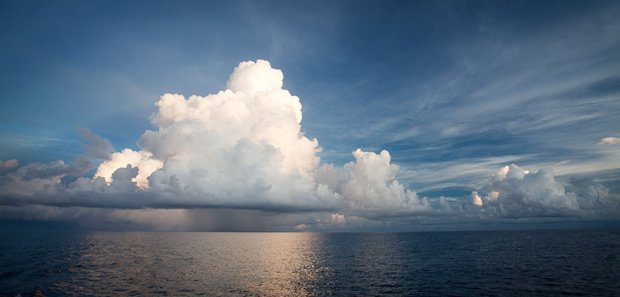Photography tips: cloud control

EVERY DAY THE CLOUDS you see are unique. They will never assume the same forms again and thus can make an image of a familiar scene completely ‘yours’. Clouds add drama and texture to skies, and the best landscape images will almost always have some sort of cloud pattern adding to the overall effect.
Clouds are also worth photographing for their own sake, particularly in the early morning and late afternoon when the low angled light picks out different parts of the clouds and gives them an almost 3-D effect. The most dramatic clouds, and the one which make some of the best images, are the common cumulus clouds, particularly the cumulus congestus variety which often evolve into the towering cumulonimbus storm clouds.

A rainbow forms in storm clouds over the sea. (Nick Rains)
These examples from the Bismark Sea, north of Papua New Guinea, were taken from the deck of a ship around sunrise. The image above (and at the end of this article) are wide shots made up of three image stitched together, and the other (to the right) is a close-up of a momentary rainbow that formed within a brief internal rain-shower.
I really enjoy the way that clouds like these hover over the sea, with their flat bottoms lined up neatly but with vast fractal billows of condensation towering up many thousands of feet. Some will be dropping localised rain and occasionally you will see the flicker of lightning within the cloud itself.
Photographing clouds is relatively easy, but it’s important to make sure the brightest parts of the white clouds do not over-expose – ‘blown out’ areas will record as a flat white with no detail, which looks odd in a print.
Use the histogram on the back of the camera to check your exposure and if parts of the images are ‘clipped’ off the right hand side of the display, or are flashing white in the preview images, consider making a second exposure with the exposure compensation set to minus one-half, or even minus one, stops. This will bring the brightest highlight back into the recordable range of the camera’s sensor and will result in a much better image.
Nick Rains is a regular photographic contributor to Australian Geographic and was recently aboard an AG Society/Orion expedition to PNG. See more of his images of Purnululu.
RELATED STORIES

